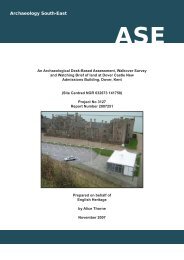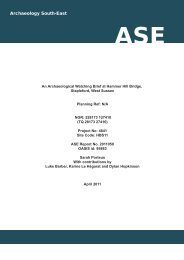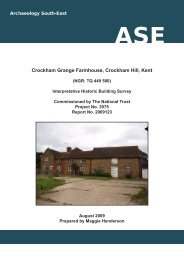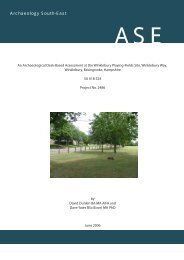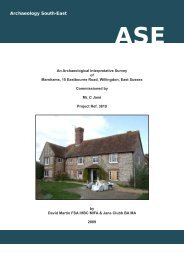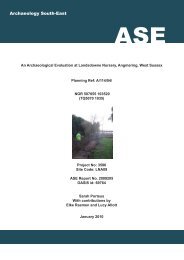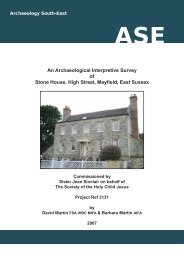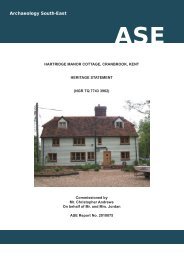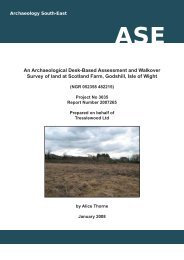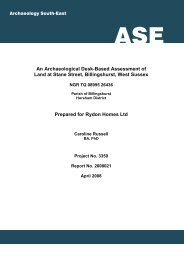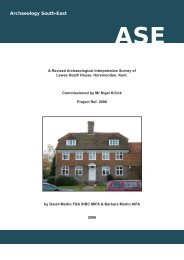ASE front cover - Archaeology South-East
ASE front cover - Archaeology South-East
ASE front cover - Archaeology South-East
You also want an ePaper? Increase the reach of your titles
YUMPU automatically turns print PDFs into web optimized ePapers that Google loves.
<strong>Archaeology</strong> <strong>South</strong>-<strong>East</strong>2008058: Holbury Infants School, Holbury, Hampshire7.0 DISCUSSION AND CONCLUSIONS7.1 The watching brief produced significant evidence for Roman activity andoccupation. The plan of the eleven archaeological features recorded withinthe open strip area suggests that the two linear features probably intersectedjust outside the area excavate, forming part of an enclosed or a partiallyenclosed area. It is possible that linear A continued to the northwestextending towards the housing estate, indicating a potential relationshipbetween this site and the other Roman finds spots in the vicinity (as recordedon the HER).7.2 The artefact assemblage enables further consideration of the site’s settingand association with other finds from the area, indicating the high likelihood ofa settlement within very close proximity to the site. The assemblagepotentially compliments well the results of fieldwork carried out by Wessex<strong>Archaeology</strong> (WA) in 1987 within the grounds of Holbury Manor, whichrevealed foundations of wattle and daub structures in association with there<strong>cover</strong>y of Roman tile and pottery. Indeed, the results of the watching briefserve to clarify the information recorded to date in the HER, the full natureand extent of which is unclear due to limited previous fieldwork and recordingduring past development.7.3 The features recorded do not provide evidence for settlement within the siteitself but the artefact assemblage suggests that there was fairly developedsettlement in the immediate vicinity. It is possible that the site, together withthat to the northwest formed a larger settlement. Placing any timescale on thisdevelopment or attributing any phasing is complicated given the limited natureof the data but it is likely to <strong>cover</strong> a broader time span than represented at thissite, which produced a chronologically homogenous artefact assemblage of cAD 270- 325/350.7.4 The evidence revealed by the watching brief facilitates a better interpretationof the HER data. The records pertaining to several hearth areas containingcharcoal and metal waste, noted to the immediate northwest during theconstruction of the housing estate, recorded at various points around the site(SMR Reference SU40SW 74; Figure 1, Point 2) and further listed as anumber of hearths observed in association with the remains of wattle anddaub and Roman pottery (SMR Reference SU40SW 48C; Figure 1, Point 7)are of particular significance in relation to the results of the watching brief.These hearths were not recorded in any detail but it is possible that they weresimilar to those recorded during the watching brief. These are possiblecontemporary with hearths/pits [1057] and [1051] or could representcontinuity of activity in a new area, with one group going out of use before thesubsequent construction and use of new features for a similar function. Thetwo areas of activity may have formed part of a larger settlement thatdeveloped and functioned as a whole or possibly forming two separate butclosely related sites.7.5 Most of the tile re<strong>cover</strong>ed during the fieldwork shows evidence of re-use insome sort of industrial process involving hearths, kilns or ovens, supportingthe functional interpretation of this area. The CBM re<strong>cover</strong>ed deriving from astructure or structures of 3 rd or early 4 th century date and the burnt clayproviding evidence for wattle and daub structures, is similar evidence to that38© <strong>Archaeology</strong> <strong>South</strong>-<strong>East</strong>



